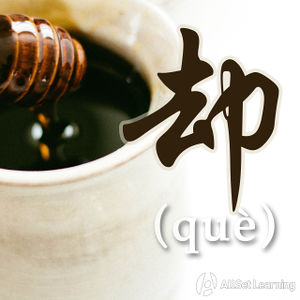The "however" adverb "que"
却 (què) is used to indicate something was contrary to expectations, and is used in a similar way to 倒 (dào). However, 却 is generally followed by a negative comment.
Contents
Structure
The overall structure of sentences that use 却 is something like this:
Sentence ,(但是 +) Subj. + 却 ⋯⋯
Normally the first clause above makes a statement, and then the second clause introduces something contrary, generally in the form of a negative comment.
Examples
In the following examples, take note that 却 comes after the subject in each case, and that it can be used together with 但是.
- 他 是 老板 ,却 没有 人 听 他 的 。He's the boss, but nobody listens to him.
- 他 的 学历 很 高 ,能力 却 很 一般 。He's very well-educated, but his ability is average.
- 他们 一见钟情 , 却 没有 在 一起 。They fell in love at first sight, but they didn't end up with each other.
- 这 件 衣服 虽然 是 名牌 ,但是 质量 却 不 怎么样 。Although this clothing is brand-name, the quality is not so good.
- 有些 人 智商 很 高 ,情商 却 很 低 。Some people have high IQ, but really low EQ.
- 他 只有 16 岁,却 比 同龄人 成熟 得 多 。He's only sixteen, but he's much more mature than others his age.
Common Mistake: Putting 却 Before the Subject
It's also important to point out that 却 is not a conjunction; it's an adverb. Practically speaking, this means that rather than joining two statements, it goes inside a statement (within the second clause). Specifically, it needs to come after the subject and before the verb. (Note that when you use a conjunction like 但是 it comes before the subject! 却 is different in this respect. Also, rather than replacing 但是, it can work with it to add emphasis.)
Sometimes the subject of the second clause will be omitted. If there is a subject, however, 却 definitely needs to come after it.
A few examples to give you a better understanding of this:
- 我 是 你 最好 的 朋友 ,却 你 没 邀请 我 。
- 我 是 你 最好 的 朋友 ,你 却 没 邀请 我 。
- 我 是 你 最好 的 朋友 ,但是 你 却 没 邀请 我 。I'm your best friend, but you didn't invite me.
- 他 家 很 有钱 ,却 他 从来 不 炫耀 。
- 他 家 很 有钱 ,他 却 从来 不 炫耀 。
- 他 家 很 有钱 ,但是 他 却 从来 不 炫耀 。His family is rich, but he never flaunts it.



